The Intel 9th Gen Review: Core i9-9900K, Core i7-9700K and Core i5-9600K Tested
by Ian Cutress on October 19, 2018 9:00 AM EST- Posted in
- CPUs
- Intel
- Coffee Lake
- 14++
- Core 9th Gen
- Core-S
- i9-9900K
- i7-9700K
- i5-9600K
Gaming: Ashes Classic (DX12)
Seen as the holy child of DirectX12, Ashes of the Singularity (AoTS, or just Ashes) has been the first title to actively go explore as many of the DirectX12 features as it possibly can. Stardock, the developer behind the Nitrous engine which powers the game, has ensured that the real-time strategy title takes advantage of multiple cores and multiple graphics cards, in as many configurations as possible.
As a real-time strategy title, Ashes is all about responsiveness during both wide open shots but also concentrated battles. With DirectX12 at the helm, the ability to implement more draw calls per second allows the engine to work with substantial unit depth and effects that other RTS titles had to rely on combined draw calls to achieve, making some combined unit structures ultimately very rigid.
Stardock clearly understand the importance of an in-game benchmark, ensuring that such a tool was available and capable from day one, especially with all the additional DX12 features used and being able to characterize how they affected the title for the developer was important. The in-game benchmark performs a four minute fixed seed battle environment with a variety of shots, and outputs a vast amount of data to analyze.
For our benchmark, we run Ashes Classic: an older version of the game before the Escalation update. The reason for this is that this is easier to automate, without a splash screen, but still has a strong visual fidelity to test.
| AnandTech CPU Gaming 2019 Game List | ||||||||
| Game | Genre | Release Date | API | IGP | Low | Med | High | |
| Ashes: Classic | RTS | Mar 2016 |
DX12 | 720p Standard |
1080p Standard |
1440p Standard |
4K Standard |
|
Ashes has dropdown options for MSAA, Light Quality, Object Quality, Shading Samples, Shadow Quality, Textures, and separate options for the terrain. There are several presents, from Very Low to Extreme: we run our benchmarks at the above settings, and take the frame-time output for our average and percentile numbers.
All of our benchmark results can also be found in our benchmark engine, Bench.
| Ashes Classic | IGP | Low | Medium | High |
| Average FPS | 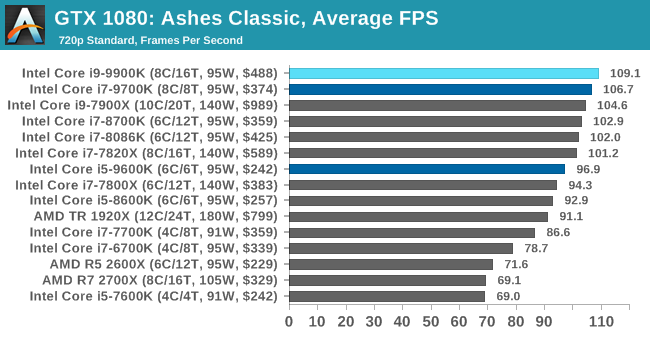 |
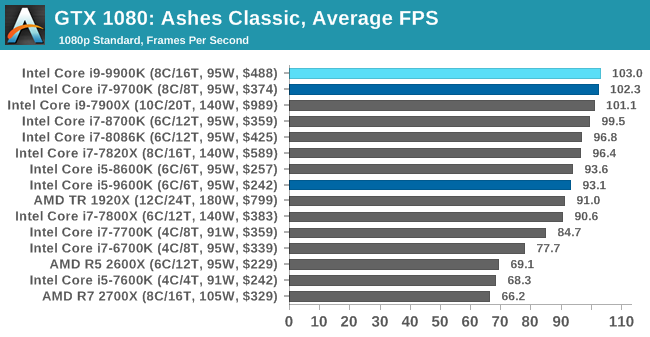 |
 |
 |
| 95th Percentile | 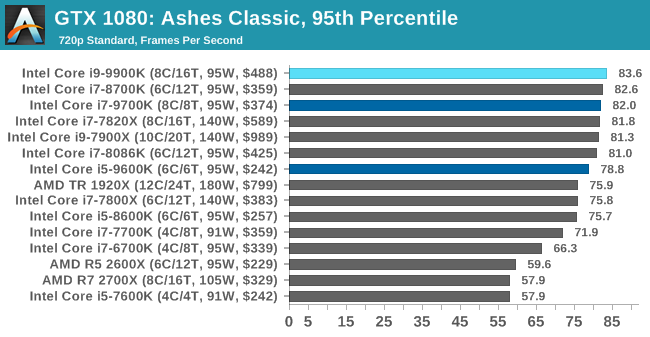 |
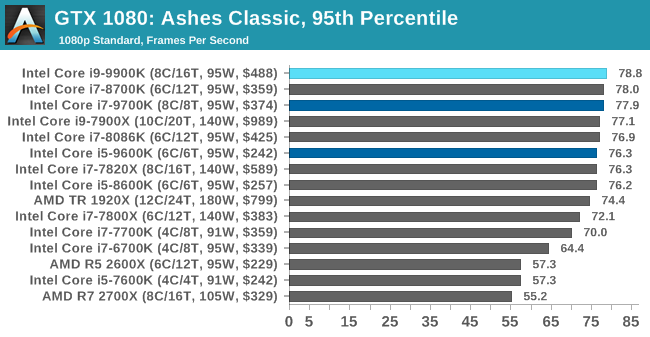 |
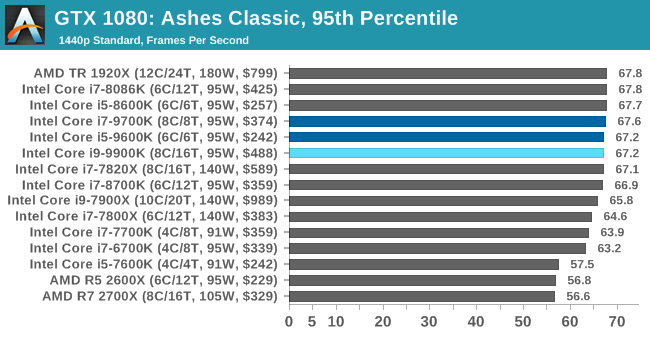 |
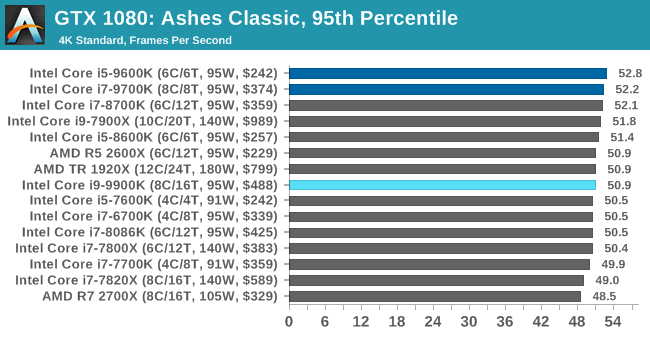 |
As a game that was designed from the get-go to punish CPUs and showcase the benefits of DirectX 12-style APIs, Ashes is one of our more CPU-sensitive tests. Above 1080p results still start running together due to GPU limits, but at or below that, we get some useful separation. In which case what we see is that the 9900K ekes out a small advantage, putting it in the lead and with the 9700K right behind it.
Notably, the game doesn’t scale much from 1080p down to 720p. Which leads me to suspect that we’re looking at a relatively pure CPU bottleneck, a rarity in modern games. In which case it’s both good and bad for Intel’s latest CPU; it’s definitely the fastest thing here, but it doesn’t do much to separate itself from the likes of the 8700K, holding just a 4% advantage at 1080p. This being despite its frequency and core count advantage. So assuming this is not in fact a GPU limit, then it means we may be encroaching on another bottleneck (memory bandwidth?), or maybe the practical frequency gains on the 9900K just aren’t all that much here.
But if nothing else, the 9900K and even the 9700K do make a case for themselves here versus the 9600K. Whether it’s the core or the clockspeeds, there’s a 10% advantage for the faster processors at 1080p.


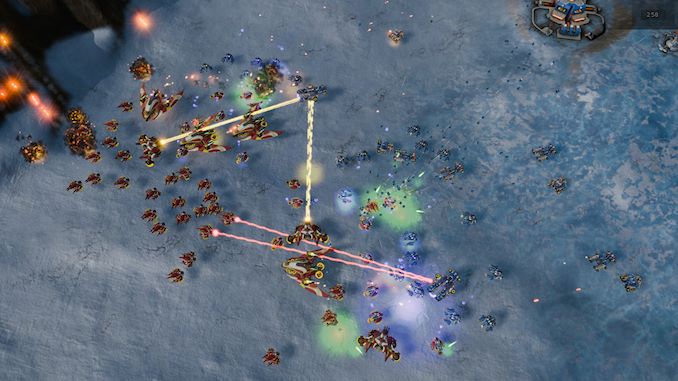









274 Comments
View All Comments
0ldman79 - Friday, October 19, 2018 - link
There are certainly occasions where more cores are better than clock speed.Just look at certain mining apps. You can drop the power usage by half and only lose a little processing speed, but drop them to 2 cores at full power instead of 4 and it is a *huge* drop. Been playing with the CPU max speed in Windows power management on my various laptops. The Skylake i5 6300HQ can go down to some seriously low power levels if you play with it a bit. The recent Windows updates have lost a lot of the Intel Dynamic Thermal control though. That's a shame.
Makaveli - Friday, October 19, 2018 - link
Power consumption rules on mobiles parts why would they release an 8 core model?notashill - Friday, October 19, 2018 - link
Because you get more performance at the same power level using more cores at lower clocks. The additional cores are power gated when not in use.evernessince - Saturday, October 20, 2018 - link
Not judging by the power consumption and heat output displayed here.mkaibear - Friday, October 19, 2018 - link
9700K is definitely the way to go on the non-HEDT. 9900K is technically impressive but the heat? Gosh.It's definitely made me consider waiting for the 9800X though - if the 7820X full load power is 145W ("TDP" 140W) at 3.6/4.3, then the 9800X isn't likely to be too much higher than that at 3.8/4.5.
Hrm.
Cooe - Friday, October 19, 2018 - link
"9700K is definitely the way to go on the non-HEDT."I think you meant to say "Ryzen 5 2600 unless your GPU's so fast, it'll HEAVILY CPU-bind you in gaming" but spelt it wrong ;). The 9700K is a vey good CPU, no doubt, but to claim it the undisputed mainstream champ at it's currently mediocre bang/$ value (so important for the mainstream market) doesn't make any sense, or accurately represent what people in the mainstream are ACTUALLY buying (lots of Ryzen 5 2600's & i5-8400's; both with a MUCH saner claim to the "best overall mainstream CPU" title).
mkaibear - Saturday, October 20, 2018 - link
No, I meant to say "9700K is definitely the way to go on the non-HEDT".Don't put words in people's mouth. I don't just game. The video encoding tests in particular are telling - I can get almost a third better performance with the 9700K than I can the r5 2600x.
>"best overall mainstream CPU" title
Please don't straw man either. Nowhere did I say that it was the best overall mainstream CPU (that's the R7 2700X in my opinion), but for my particular use case the 9700K or the 9800X are better suited at present.
koaschten - Friday, October 19, 2018 - link
Uhm yeah... so where are the 9900k overclocking results the article claims are currently being uploaded? :)watzupken - Friday, October 19, 2018 - link
The i9 processor is expected to be quite impressive in performance. However this review also reveals that Intel is struggling to pull more tricks out of their current 14nm and Skylake architect. The lack of IPC improvement over the last few generations is just forcing them to up the clockspeed to continue to cling on to their edge. Considering that they are launching the new series this late in the year, they are at risk of AMD springing a surprise with their 7nm Zen 2 slated to launch next year.SquarePeg - Friday, October 19, 2018 - link
If the rumored 13% IPC and minimum 500mhz uplift are for real with Zen 2 then AMD would take the performance crown. I'm not expecting very high clocks from Intel's relaxed 10nm process so it remains to be seen what kind of IPC gain they can pull with Ice Lake. It wouldn't surprise me if they had a mild performance regression because of how long they had to optimize 14nm for clock speed. Either way I'm all in on a new Ryzen 3 build next year.